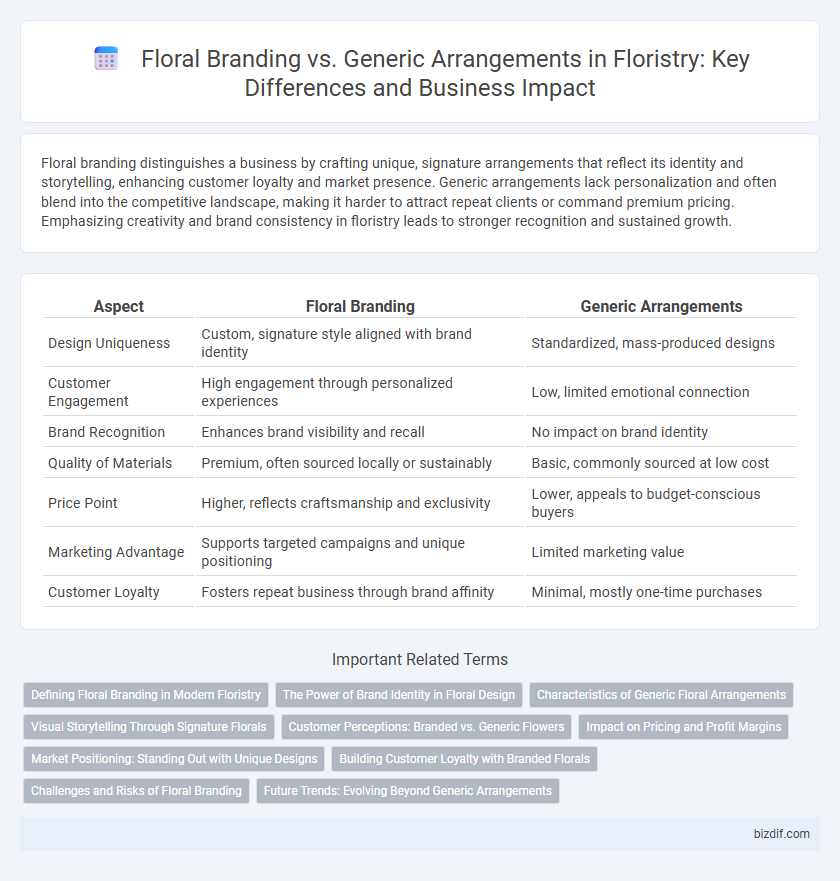Floral branding distinguishes a business by crafting unique, signature arrangements that reflect its identity and storytelling, enhancing customer loyalty and market presence. Generic arrangements lack personalization and often blend into the competitive landscape, making it harder to attract repeat clients or command premium pricing. Emphasizing creativity and brand consistency in floristry leads to stronger recognition and sustained growth.
Table of Comparison
| Aspect | Floral Branding | Generic Arrangements |
|---|---|---|
| Design Uniqueness | Custom, signature style aligned with brand identity | Standardized, mass-produced designs |
| Customer Engagement | High engagement through personalized experiences | Low, limited emotional connection |
| Brand Recognition | Enhances brand visibility and recall | No impact on brand identity |
| Quality of Materials | Premium, often sourced locally or sustainably | Basic, commonly sourced at low cost |
| Price Point | Higher, reflects craftsmanship and exclusivity | Lower, appeals to budget-conscious buyers |
| Marketing Advantage | Supports targeted campaigns and unique positioning | Limited marketing value |
| Customer Loyalty | Fosters repeat business through brand affinity | Minimal, mostly one-time purchases |
Defining Floral Branding in Modern Floristry
Floral branding in modern floristry emphasizes creating unique, signature designs that reflect a florist's identity and style, distinguishing them from generic arrangements. This approach utilizes curated color palettes, specific flower choices, and innovative presentation techniques to build brand recognition and emotional connections with customers. Investing in floral branding enhances customer loyalty and elevates the perceived value of arrangements within competitive markets.
The Power of Brand Identity in Floral Design
Floral branding leverages unique design elements, colors, and packaging to create a memorable and distinguishable identity that resonates with customers, setting the business apart from generic arrangements. Strong brand identity in floristry enhances customer loyalty and perceived value, allowing florists to command premium pricing and foster emotional connections through personalized experiences. Investing in brand consistency across all touchpoints elevates the floral business and transforms simple bouquets into signature creations recognized for quality and style.
Characteristics of Generic Floral Arrangements
Generic floral arrangements typically feature widely available flowers arranged in conventional patterns lacking unique design elements or personal branding. These bouquets prioritize affordability and ease of production, often using mass-market flowers like carnations, daisies, and roses without customization. The result is a uniform appearance that may suit general occasions but lacks the distinctiveness and emotional impact of branded floral designs.
Visual Storytelling Through Signature Florals
Floral branding leverages unique, signature arrangements that visually convey a brand's identity, creating a memorable and cohesive aesthetic across all touchpoints. These custom floral designs use distinct color palettes, flower varieties, and styling techniques that resonate emotionally with the target audience and differentiate the brand from generic, mass-produced bouquets. Visual storytelling through signature florals enhances brand recognition, strengthens customer loyalty, and elevates the overall experience by transforming flowers into a compelling narrative tool.
Customer Perceptions: Branded vs. Generic Flowers
Floral branding significantly influences customer perceptions by conveying quality, uniqueness, and emotional value compared to generic arrangements. Branded flowers often evoke trust and a sense of luxury through consistent design, premium sourcing, and distinctive packaging. Customers perceive branded floral arrangements as more thoughtful and memorable, driving higher satisfaction and loyalty than generic, mass-produced bouquets.
Impact on Pricing and Profit Margins
Floral branding enhances perceived value by creating unique, signature designs that justify premium pricing, leading to higher profit margins compared to generic arrangements. Branded floristry leverages market differentiation and customer loyalty, allowing florists to command price premiums and reduce price sensitivity. Generic floral arrangements face intense competition and commoditization, which typically compresses profit margins and limits pricing flexibility.
Market Positioning: Standing Out with Unique Designs
Floral branding leverages unique designs and signature styles that resonate with target audiences, creating strong brand recognition and emotional connections. Generic arrangements often lack differentiation, making it difficult to capture niche markets or justify premium pricing. Distinctive floral designs position businesses as industry leaders, driving customer loyalty and market presence.
Building Customer Loyalty with Branded Florals
Floral branding distinguishes businesses by creating unique, memorable arrangements that reflect a signature style, fostering strong customer recognition and emotional connection. Consistent use of branded elements such as custom packaging, distinctive flower combinations, and personalized messages enhances perceived value and encourages repeat purchases. This approach drives customer loyalty by transforming ordinary transactions into meaningful experiences, setting branded florists apart from generic competitors.
Challenges and Risks of Floral Branding
Floral branding faces challenges such as maintaining consistent design quality and distinguishing the brand in a saturated market, which requires ongoing investment in creativity and marketing. Risks include potential customer confusion if brand identity is unclear, and the vulnerability to changing floral trends that can quickly render signature styles outdated. Misaligned branding strategies can also alienate target audiences, reducing customer loyalty and sales growth.
Future Trends: Evolving Beyond Generic Arrangements
Floral branding emphasizes unique, signature designs that create emotional connections and lasting impressions, setting florists apart from generic arrangements. Future trends highlight the integration of sustainability, seasonal local blooms, and personalized storytelling to enhance brand identity and customer loyalty. Embracing technology-driven customization and eco-friendly practices will redefine floristry, moving it beyond mass-produced, generic bouquets toward bespoke, meaningful floral experiences.
Floral Branding vs Generic Arrangements Infographic

 bizdif.com
bizdif.com